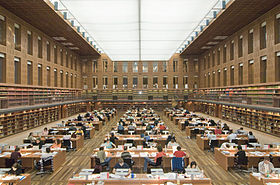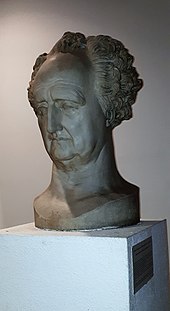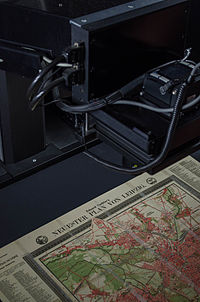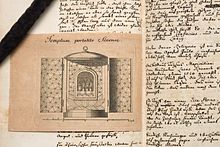Saxon State Library - Dresden State and University Library
| Saxon State Library - Dresden State and University Library | |
|---|---|
|
|
|
| founding | 1556 and 1828 |
| Library type | universal scientific library |
| place | Dresden |
| ISIL | DE-14 |
| management | Achim Bonte |
| Website | www.slub-dresden.de |
The Saxon State Library - Dresden State and University Library ( SLUB Dresden ) was created in 1996 from the merger of the library of the Technical University and the Saxon State Library (SLB). Originating from the (electoral) princely book collection from the 16th century, it is one of the oldest libraries in Germany and has been open to the public as a state library since 1788. The apparently redundant name of the library is intended to indicate that the state library is both the state library of the Free State of Saxony and the university library of the TU Dresden ( Section 1, Paragraph 2 SächsLBG).
In 2002 the SLUB moved into a large new building from the architectural office O&O Baukunst on Zellescher Weg, in which the holdings were brought together. With a holdings of over 17 million media, it is one of the four largest libraries in Germany and, as a state bibliography facility, has the right to deposit copies for literature published in Saxony.
The SLUB has 2.3 million visitors annually.
history
History of the State Library
The Saxon State Library was founded in 1556 by Elector August I , making it one of the oldest libraries in Germany. As an old court library, its value as a collection of book art and its content of information for the Saxon state history is established . The book collection, which was originally housed in the Dresden Residenzschloss , was moved from Dresden to Annaburg Palace as early as 1574 . In the course of the relocation, the first specialist catalog was created. The catalog contained 2,736 texts in 1,674 volumes.

After he took office in 1586, Elector Christian I had the library returned to the Dresden residential palace. In 1589 the holdings were expanded to include the 3,312 collection of the Thuringian Counts of Werthern . In the 17th century, library management was the responsibility of the upper court preachers at the Saxon court, including Polykarp Leyser the Elder (management 1593–1610), Paul Jenisch (management 1610–1612), Matthias Hoë von Hoënegg (management 1613–1645), Jakob Weller (management 1645–1664) and Martin Geier (line 1664–1680). From 1640 poets and poets took over the care of the library, including Christian Brehme and the baroque lyricist David Schirmer . At the end of the 17th century, the collection comprised less than 7,000 volumes.
From 1680 the library management changed from clerical to secular hands, from now on various people who belonged to the elite of the nobility at the Saxon court took over the management of the library. In this role, a. Friedrich I. Vitzthum von Eckstädt (management 1714–1726) and Heinrich Friedrich von Friesen (1727–1733). In 1738 Prime Minister Heinrich von Brühl took over the management of the library himself (management until 1763).
The library's holdings grew steadily in the 18th century. In 1718 the inventory increased by almost 1,000 books from the estate of Duke Moritz Wilhelm von Sachsen-Zeitz , including an octagonal Koran from 1184 and a copy of the Mainz Bible printed by Peter Schöffer in 1462 . In 1727, around 18,000 volumes from Johann von Besser's estate came into the possession of the library.
Until 1728 the library was housed in the Dresden Residenzschloss and was then moved to the Zwinger . For the first time, the book collection was also housed in a structurally representative manner.
In 1739 the library came into the possession of the Codex Dresdensis , which could be identified as the Maya manuscript in the 19th century . The Codex Dresdensis is one of the most valuable copies of the library today; there are currently only three other Maya manuscripts left worldwide.
After the purchase of further collections, including the library of Count von Brühl and that of Count von Bünau , which had previously been looked after by Johann Joachim Winckelmann as librarian at Schloss Nöthnitz , the library overcrowded the pavilion in the Zwinger so that it was converted to Japanese in 1786 Palais in the Neustadt was relocated, where it remained until 1945.
In 1788 the library was opened to the public under the name Bibliotheca Electoralis Publica . The public presentation of the electoral book collection took place around 50 years later than that of the treasury in the Green Vault . When the Kingdom of Saxony was founded in 1806, it was named the Royal Public Library . From 1825 it was under the direction of Friedrich Adolf Ebert . At the end of the 19th century the library was expanded to include cartographic and musical collections.
When the Free State of Saxony was established in 1918, the library was given the name Sächsische Landesbibliothek for the first time , which it continues to bear up to the present day. The book museum was opened in 1935 after the site in the Japanese Palace was modernized again.
In 1945 the library was hit and destroyed in the air raids on Dresden . The stock also halved as a result of spoils of war from the Soviet Union . After the war, the library was moved to Albertstadt and was accessible again from 1949. In 1966, through a merger, the library became part of the very large collection of shorthand writings of the Stenographic Institute . In 1983, the library was expanded again by assigning the German Photo Library to it.
History of the university library
The university library was created in 1828 as the library of the Royal Saxon Educational Institute . Between 1851 and 1890 the educational institution was called the Royal Saxon Polytechnic School. In 1872 the university and library were relocated near today's main train station. In 1890 the collection became the library of the Technical University and thus a university library according to today's standards.
In 1945 the university library was also destroyed and the holdings reduced. The library was moved to a villa on the current campus of the university, where the rector's office of the Technical University of Dresden is now located . Under the direction of Helene Benndorf , the destroyed subject catalog was rebuilt, but also the university central catalog and the reopening of the patent publication department. The name was changed to Technical University in 1961, which also resulted in the name of the university library. Since 1977, lending has been centrally controlled in the section libraries and today's branch libraries.
After 1990 the TU Dresden was expanded to a full university and the library was supplemented by branch libraries for economics and law . In 1992 the TU and the University of Transport were merged and their library was taken over . In 1993 the university library was again expanded to include a branch library when the research and teaching facilities of the dissolved Dresden Medical Academy were assigned to the TU.
In 1997 the branch library for educational sciences moved to August-Bebel-Straße. In the following year, the Dre.Punct departmental library opened, in which several faculty libraries were absorbed.
With the merger with the State Library, the new construction of the central building on the campus of the TU Dresden began in 1999. On August 1, 2002, the SLUB was opened to users. Its official inauguration took place on January 14, 2003. This offers good working conditions , especially thanks to the large reading room and the carrels .
building
The central building of the SLUB was built from 1999 to 2002 and designed by the architects O & O Baukunst . The building offers 1000 reading spaces on more than 40,000 square meters, 200 of which are in the large reading room, the administration and the numerous special collections. With this new building, the numerous locations in Dresden ( Albertstadt , Martinskirche and at the individual faculties) were given up and brought together centrally. The construction costs were around 90 million euros.
Two rooms in the north wing of the main building are of particular importance: the Zimelienzimmer of the SLUB Book Museum and the Klemperer Hall.
Klemperer Hall
The northern library building contains a lecture hall on the first floor, which was opened in 2002. In the meantime, its use has expanded to include concerts, film performances, receptions, readings and dance events in addition to lectures. In particular, works from the so-called Schranck No: II have been performed there in loose succession since 2008 . In 2018, the name Klemperer-Saal was named after the personalities who deserve both the TUD and the TUD: the Romanist Viktor Klemperer , the Dresden banker Victor Klemperer von Klemenau and his father Gustav Klemperer (1852–1926), director of the Dresdner Bank and Honorary Senator of TUD. In front of the Klemperer Hall is Goethe's marble bust , a gift from the French sculptor and medalist Pierre Jean David d'Angers in 1831 to the then Royal Public Library in Dresden, today's SLUB.
Locations
In addition to the central library on Zellescher Weg, the SLUB has five other locations. The DrePunct library is located opposite the central building. It integrates the branch libraries of the TU Dresden faculties for civil engineering, electrical engineering, geosciences, computer science, mechanical engineering, economics and transport sciences and, since 2014, the SLUB makerspace . The faculties of Education (August-Bebel-Straße), Medicine (Fiedlerstraße), Law ( Bergstraße ) and Forestry ( Tharandt ) have independent branches of the SLUB.
Stocks
The library has over five million inventory units (volumes). She's Special Collections Library of the German Research Foundation for the "Contemporary Art from 1945". The collection extends to the holdings of the Deutsche Fotothek through its collection topics such as advertising photography , documentary photography and the art of photography.
The first surviving index of the state library's holdings dates from 1574 and can also be searched on the Internet. Other services on the Internet are the map forum with historical maps of Saxony and the photo library, which offers image documents for research.
German photo library
The Deutsche Fotothek is based on the tradition of Dresden both in photo technology and camera production as well as in photo art. The Landesbildstelle was originally set up in Chemnitz, but was relocated to Dresden shortly afterwards in 1925. Since 1956 the collection has been called the German Photo Library. Since 1983 it has belonged to the Saxon State Library as a separate department. With several million photo documents, the photo library has a very large share of all inventory units. The oldest pictures around 1850 go back to the photographer Hermann Krone .
Manuscripts and rare prints
In addition to the open access or magazine holdings, the treasury has a special collection, including a copy of the Maya manuscript Codex Dresdensis , which Saxony acquired in 1739, dated around 1200 AD . Otherwise there are only three codes left in Paris , Madrid and Mexico . The Codex is a candidate for inclusion in the World Document Heritage . The extensively restored Dresden Sachsenspiegel is exhibited in the treasury six weeks a year. As part of the Bibliotheca Corviniana, the Dresden Corvines were included in the list of World Document Heritage in 2005.
Digital collections
The SLUB Dresden has been operating the Dresden Digitization Center since 2007 and has continuously expanded it to a capacity of 3 million pages per year. Since then, more than 100,000 volumes have been digitized and can be used in the digital collections. For the German Digital Library, which has been online since November 2012, the SLUB is one of the largest data providers. This is also made possible by third-party funding, in particular by the German Research Foundation . For example, the SLUB is involved in the digitization of directories of prints from the 17th and 18th centuries published in the German-speaking area, in electronic editions such as the August Wilhelm Schlegel collection or illustrated magazines of classical modernism. The SLUB's digital collections currently contain around 80,000 titles, over 100,000 volumes and around 1.5 million graphic media (photos, maps, drawings). The Goobi open source software used for the digitization workflow has been significantly further developed in order to be able to process and display various types of media.
Contemporary art from 1945, photography, industrial design and commercial graphics
The library already had a collecting focus on art after 1945 in the library landscape of the GDR. In 1993, the DFG began funding the collection area. Subjects of photography, industrial design and commercial art belong to the collection without any time limit. The collections are roughly linked to the special collection area Middle and Modern Art History up to 1945 and General Art History of the Heidelberg University Library .
The holdings in the special collection area include around 200,000 volumes and 330 journals. Collected literature deals with the art history of Europe and North America and art theory with concrete painting, graphics, sculpture and handicrafts as well as with new art forms such as land art , digital art , video art , action art and others.
With the support of the DFG, the SLUB built up the virtual specialist library for contemporary art ViFaArt from January 2001 to August 2004 . Since 2012, the offers of the virtual specialist library for contemporary art and "arthistoricum.net - Virtual specialist library art history", which were previously presented separately, have been combined in a joint virtual specialist library for art under the name arthistoricum.net . The specialist information service now includes art, photography and design.
Saxonica
Saxonica have been systematically collected at the Electoral Library since the late 18th century, during the tenure of Johann Christoph Adelung . While the collection was initially focused on literature on Saxon history, the Saxonica term began to expand in the 19th century to include other areas of science with regional references such as natural and folklore, geography, antiquity and linguistics. Today, the term "Saxonica" includes German and foreign language publications that relate content to Saxony and its sub-areas (natural and cultural areas, administrative units, historical regions, etc.), its locations and the deceased and living personalities associated with the country.
Saxonica have been listed in the Saxon Bibliography since the beginning of the 20th century . The founder of this regional bibliography was Rudolf Bemmann , followed by Jakob Jatzwauk . With the exception of manuscripts and photographs, all Saxonica published since 1992 are listed in the Saxon Bibliography Online. The conversion of the previous print editions up to the reporting year 1991 has been completed; this evidence can also be researched online.
The collection and archiving of literature, image and sound carriers about Saxony as well as the development of the Saxon bibliography are the tasks of the Saxon State and University Library Dresden ( § 2 SLUBG).
Card collection
The map collection includes map sheets with a focus on Saxon cartography but also historical maps of Europe and Germany. The map collection comprises around 138,000 individual sheets of which 19,650 up to and including 1800 and 41,600 were created between 1801 and 1945, as well as other sheets drawn after 1945. The collection serves as a scientific source of the state's history in general, but also for the history of individual places, castles and palaces as well as for the historical development of space, landscape and traffic. About 11,000 sheets of the collection are still believed to be in Russia.
The SLUB's card forum is an information portal for libraries, museums and archives maintained by the Deutsche Fotothek and funded by the DFG. Currently around 20,000 of the most important, high-resolution digitized cartographic sources - in particular on the history and regional studies of Saxony - are offered from the collections of the partners involved.
Music department
The music department contains several hundred thousand volumes. The department is divided into the two collections New Prints and Manuscripts and Old Prints , with Old Prints comprising the holdings that were created before 1850. The department is closely interwoven with the media library, which contains music recordings, the photo library, which holds music-iconographic materials, and the manuscript collection, which also includes letters from musicians.
The department was founded in 1816 by Friedrich Adolf Ebert by merging the previously divided holdings Musica theoretica and Musica practica . The department was expanded by 1934, for example to include the King's private collection by Albert or holdings from the State Opera . In 1983 the regional library became the central library of the GDR for art and music . In 2016 the SLUB celebrates the 200th anniversary of the music department.
The 2nd phase of the Musicology Information Service (FID Musicology) started in January 2017 . In the project funded by the German Research Foundation, the Bavarian State Library and the SLUB provide information services for top musicological research throughout Germany.
Awards
The library received an award for its extensive work in the field of digitization on February 22, 2009 as part of the Germany, Land of Ideas initiative.
literature
- The ABC of the SLUB. Lexicon of the Saxon State Library - State and University Library Dresden; On the occasion of the 450th anniversary on behalf of the Society of Friends and Sponsors of SLUB Dresden eV Ed. by Thomas Bürger and Konstantin Hermann. Dresden 2006. (Series of publications of the Saxon State Library - State and University Library, Vol. 11) ( digital copy; PDF )
- Thomas Bürger: Change and continuity in 450 years. From the electoral Liberey to the Saxon State Library - State and University Library . in: Scientific journal of the Technical University of Dresden, 55 (2006) 1-2, pp. 30–36 ( digital version ; PDF; 1.2 MB)
- Friedrich Adolf Ebert: History and description of the royal public library to Dresden . Leipzig 1822 ( digitized )
- Saxon State Library - State and University Library Dresden (Ed.): Tradition and Challenge. From the work of the Saxon State Library between 1960 and 1990 . Dresden 2000
- Sächsische Landesbibliothek - Staats- und Universitätsbibliothek Dresden (Ed.): Sächsische Landesbibliothek - Staats- und Universitätsbibliothek Dresden: Festschrift on the occasion of the inauguration of the new building , Sandstein-Verlag, Dresden, 2002, ISBN 3-930382-81-4
- Saxon State Ministry of Finance (Ed.): Sächsische Landesbibliothek - State and University Library Dresden , Dresden, 2002
Older library catalogs and directories
- Registration of the books in des Churfursten zu Saxen liberey zur Annaburg 1574 ( digitized version )
- Johann Christian Götze: Books, as delivered by me to the K. Bibliothec in Jan. 1740 ( digitized version )
- Friedrich Adolf Ebert: Notitia codicum praestantiorum bibliothecae regiae Dresdensis , Dresden 1850 ( digitized version )
Web links
- SLUB Dresden
- German photo library
- SACHSEN.digital
- Saxon State Library - Dresden State and University Library in the German Digital Library
Individual evidence
- ^ Change of office in the SLUB: Dr. Achim Bonte becomes the new general director . (accessed on May 15, 2018).
- ↑ Registration of the books in des Churfursten zu Saxen liberey zur Annaburg 1574
- ^ SLUB Dresden - First library catalogs ( Memento from January 3, 2015 in the Internet Archive )
- ↑ Thomas Bürger: Change and Continuity in 450 Years. From the electoral Liberey to the Saxon State Library - State and University Library. in: Scientific journal of the Technical University of Dresden, 55 (2006) 1-2, p. 30
- ↑ Thomas Bürger: Change and Continuity in 450 Years. From the electoral Liberey to the Saxon State Library - State and University Library. in: Scientific journal of the Technical University of Dresden, 55 (2006) 1-2, p. 31
- ^ SLUB Dresden - The Dresden Maya Codex
- ^ Fritz Löffler: The old Dresden - history of its buildings . EASeemann, Leipzig 1981, ISBN 3-363-00007-3 , p. 144.
- ↑ https://www.ortner-ortner.com/de/baukunst/projekte/kultur/slub-dresden
- ↑ Bemmann, Katrin; Voss, Steffen: A sheet music cabinet is going online. Retrieved November 11, 2019 .
- ↑ Schneider, Christina: Our lecture hall gets a name: Klemperer Hall. June 29, 2018, accessed November 11, 2019 .
- ↑ Key figures on the SLUB Dresden website, accessed on July 10, 2013
- ^ Special collection of contemporary art from 1945
- ^ Index from 1574
- ^ Image database of the Deutsche Fotothek
- ^ The Dresden Codex . 1200-1250. Retrieved August 21, 2013.
- ↑ The Sachsenspiegel in the Book Museum (slub-dresden.de) accessed on September 20, 2012
- ↑ Digital collections of the SLUB accessed on January 9, 2015
- ↑ Saxon Bibliography Online
- ^ Map forum of the SLUB Dresden
- ↑ Germany, Land of Ideas ( Memento of the original from March 30, 2009 in the Internet Archive ) Info: The archive link was automatically inserted and not yet checked. Please check the original and archive link according to the instructions and then remove this notice.
Coordinates: 51 ° 1 ′ 41.5 ″ N , 13 ° 44 ′ 12.4 ″ E













